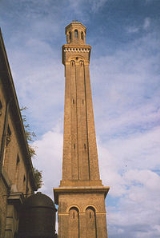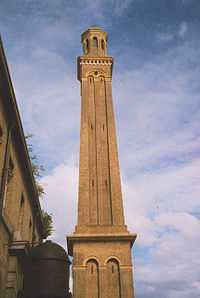
Grand Junction Waterworks Company
Encyclopedia
The Grand Junction Waterworks Company was a utility company supplying water
to parts of west London
in England
. The company was formed as an off-shoot of the Grand Junction Canal
Company in 1811 and became part of the publicly-owned Metropolitan Water Board in 1903.
and River Brent
, and from a reservoir in the north-west Middlesex supplied by land drainage. It was thought that these waters would be better than those of the Thames, but in fact they were found to be of poor quality and insufficient to meet demand. After trying to resolve these problems the company resorted to taking their supply from the River Thames
at a point near Chelsea Hospital
 The Grand Junction Waterworks Company built a pumping station near Kew Bridge
The Grand Junction Waterworks Company built a pumping station near Kew Bridge
at Brentford
in 1838 to house its new steam pump and two similar pumps purchased from Boulton, Watt and Company in 1820. The water was taken from the middle of the river and pumped into filtering reservoirs and to a 200 ft high water tower to provide gravity feed to the area. A six and seven mile main took the water to a reservoir on Campden Hill
near Notting Hill
capable of containing 6 million gallons. The Kew Bridge faciities now house the Kew Bridge Steam Museum
.
In the 1850s the quality of drinking water was of public concern. Charles Dickens
took an interest in the topic and in carrying out research, he visited the Kew Bridge Pumping Station in March 1850. He recorded details of his visit in his campaigning journal Household Words, in an article published in April 1850 entitled "The Troubled Water Question". The report of the epdemiologist John Snow
on an outbreak of cholera
pinpointed a workhouse in Soho which escaped the contagion because it was supplied by Grand Junction rather than the other local supply. The Metropolis Water Act 1852 was enacted in order to "make provision for securing the supply to the Metropolis of pure and wholesome water. Under the Act, it became unlawful for any water company to extract water for domestic use from the tidal reaches of the Thames after 31 August 1855, and from 31 December 1855 all such water was required to be "effectually filtered". Accordingly, new waterworks had to be constructed further up river and the Grand Junction Waterworks Company was one of three companies that opened new facilities at Hampton
above Sunbury Lock
in the 1850s. The company took its water from an island in the River Thames that thereby acquired the name Grand Junction Isle
.
Water supply
Water supply is the provision of water by public utilities, commercial organisations, community endeavours or by individuals, usually via a system of pumps and pipes...
to parts of west London
London
London is the capital city of :England and the :United Kingdom, the largest metropolitan area in the United Kingdom, and the largest urban zone in the European Union by most measures. Located on the River Thames, London has been a major settlement for two millennia, its history going back to its...
in England
England
England is a country that is part of the United Kingdom. It shares land borders with Scotland to the north and Wales to the west; the Irish Sea is to the north west, the Celtic Sea to the south west, with the North Sea to the east and the English Channel to the south separating it from continental...
. The company was formed as an off-shoot of the Grand Junction Canal
Grand Junction Canal
The Grand Junction Canal is a canal in England from Braunston in Northamptonshire to the River Thames at Brentford, with a number of branches. The mainline was built between 1793 and 1805, to improve the route from the Midlands to London, by-passing the upper reaches of the River Thames near Oxford...
Company in 1811 and became part of the publicly-owned Metropolitan Water Board in 1903.
Origins
The company was created in 1811 to take advantage of a clause in the Grand Junction Canal Company's Act which allowed them to supply water brought by the canal from the River ColneRiver Colne, Hertfordshire
The Colne is a river in England which is a tributary of the River Thames. It flows mainly through Hertfordshire and forms the boundary between the South Bucks district of Buckinghamshire and the London Borough of Hillingdon...
and River Brent
River Brent
The Brent is a river within Greater London which is a tributary of the River Thames. It is 17.9 miles long, running north-east to south-west, and it joins the Thames on the Tideway at Brentford, Hounslow.- Hydronymy and etymology :...
, and from a reservoir in the north-west Middlesex supplied by land drainage. It was thought that these waters would be better than those of the Thames, but in fact they were found to be of poor quality and insufficient to meet demand. After trying to resolve these problems the company resorted to taking their supply from the River Thames
River Thames
The River Thames flows through southern England. It is the longest river entirely in England and the second longest in the United Kingdom. While it is best known because its lower reaches flow through central London, the river flows alongside several other towns and cities, including Oxford,...
at a point near Chelsea Hospital
Infrastructure

Kew Bridge
Kew Bridge is a bridge in London over the River Thames. The present bridge was designed by John Wolfe-Barry and opened in 1903 by King Edward VII. The bridge was givenGrade II listed structure protection in 1983.- Location :...
at Brentford
Brentford
Brentford is a suburban town in west London, England, and part of the London Borough of Hounslow. It is located at the confluence of the River Thames and the River Brent, west-southwest of Charing Cross. Its former ceremonial county was Middlesex.-Toponymy:...
in 1838 to house its new steam pump and two similar pumps purchased from Boulton, Watt and Company in 1820. The water was taken from the middle of the river and pumped into filtering reservoirs and to a 200 ft high water tower to provide gravity feed to the area. A six and seven mile main took the water to a reservoir on Campden Hill
Campden Hill
Campden Hill is an area of high ground in west London between Notting Hill, Kensington and Holland Park.The area is characterised by large Victorian houses. It is also the site of reservoirs established in the 19th century by the Grand Junction Waterworks Company and the West Middlesex Waterworks...
near Notting Hill
Notting Hill
Notting Hill is an area in London, England, close to the north-western corner of Kensington Gardens, in the Royal Borough of Kensington and Chelsea...
capable of containing 6 million gallons. The Kew Bridge faciities now house the Kew Bridge Steam Museum
Kew Bridge Steam Museum
Kew Bridge Steam Museum houses a museum of water supply and a collection of water pumping steam engines. The museum is an Anchor Point of ERIH, The European Route of Industrial Heritage...
.
In the 1850s the quality of drinking water was of public concern. Charles Dickens
Charles Dickens
Charles John Huffam Dickens was an English novelist, generally considered the greatest of the Victorian period. Dickens enjoyed a wider popularity and fame than had any previous author during his lifetime, and he remains popular, having been responsible for some of English literature's most iconic...
took an interest in the topic and in carrying out research, he visited the Kew Bridge Pumping Station in March 1850. He recorded details of his visit in his campaigning journal Household Words, in an article published in April 1850 entitled "The Troubled Water Question". The report of the epdemiologist John Snow
John Snow (physician)
John Snow was an English physician and a leader in the adoption of anaesthesia and medical hygiene. He is considered to be one of the fathers of epidemiology, because of his work in tracing the source of a cholera outbreak in Soho, England, in 1854.-Early life and education:Snow was born 15 March...
on an outbreak of cholera
Cholera
Cholera is an infection of the small intestine that is caused by the bacterium Vibrio cholerae. The main symptoms are profuse watery diarrhea and vomiting. Transmission occurs primarily by drinking or eating water or food that has been contaminated by the diarrhea of an infected person or the feces...
pinpointed a workhouse in Soho which escaped the contagion because it was supplied by Grand Junction rather than the other local supply. The Metropolis Water Act 1852 was enacted in order to "make provision for securing the supply to the Metropolis of pure and wholesome water. Under the Act, it became unlawful for any water company to extract water for domestic use from the tidal reaches of the Thames after 31 August 1855, and from 31 December 1855 all such water was required to be "effectually filtered". Accordingly, new waterworks had to be constructed further up river and the Grand Junction Waterworks Company was one of three companies that opened new facilities at Hampton
Hampton, London
Hampton is a suburban area, centred on an old village on the north bank of the River Thames, in the London Borough of Richmond upon Thames in England. Formerly it was in the county of Middlesex, which was formerly also its postal county. The population is about 9,500...
above Sunbury Lock
Sunbury Lock
Sunbury Lock is a lock on the River Thames in England near Walton-on-Thames in north-west Surrey. The lock adjoins the southern bank about half a mile downstream of the Weir Hotel....
in the 1850s. The company took its water from an island in the River Thames that thereby acquired the name Grand Junction Isle
Grand Junction Isle
Grand Junction Isle is an island in the River Thames on the reach above Molesey Lock at Sunbury-on-Thames, Surrey, England. It is just downstream of Sunbury Court Island...
.

